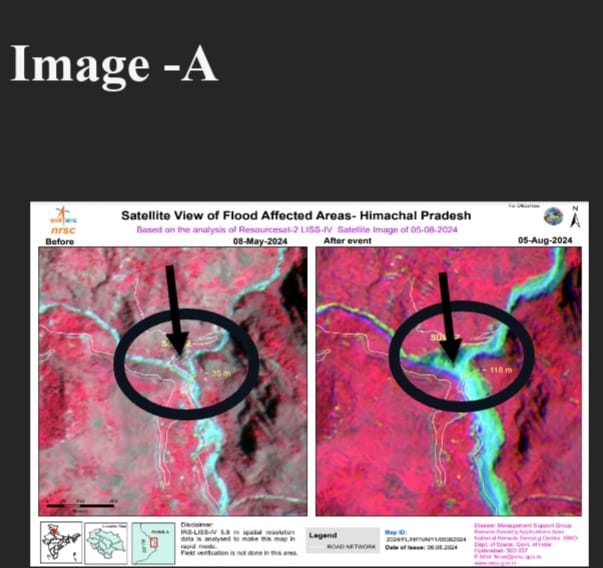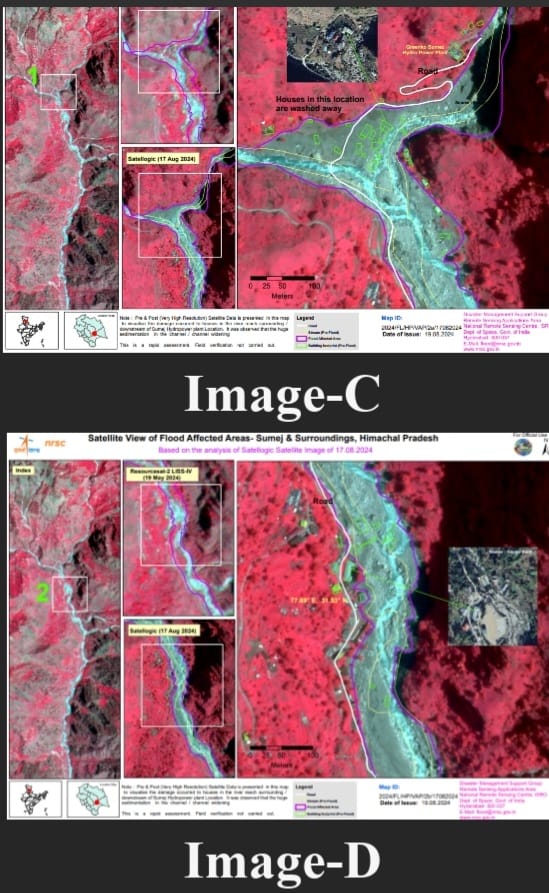SHIMLA: For over three decades, Himachal Pradesh has been caught in a loop of devastation—flash floods, cloudbursts, and landslides tearing through its villages, roads, and bridges, year after year. And every single time, the state’s disaster management machinery responds with its classic line: “further studies needed.”
But while they talk about studies like some kind of yearly ritual, hundreds of lives are lost, entire villages wiped out, and the out hills scarred beyond recognition.
What has the Himachal Pradesh State Disaster Management Authority (HPSDMA) done, really? Geo-tagging vulnerable spots around khads, and hill depressions, identify vulnerable villages along the rivers or khads? No.
Moving beyond endless meetings to actually save lives? Answer is Certainly not.
Kurpan Khad Swells from 38 to 218 Meters, Wipes Out 16 Houses, Remote Sensing Data Reveals the officials who had a meeting here today to appropriate the losses during the Monsoons this year in Himachal Pradesh.
Like 2023, the 2024 monsoon season has yet again left its terrifying mark on Himachal.
Take Rampur for instance: the Kurpan Khad swelled from 38 meters to a massive 218 meters, which together with Samej khad obliterated 16 homes in Samej.
The National Remote Sensing Centre (NRSC) confirmed the nightmare through satellite images, showing how the flood spread like wildfire, leaving nothing but ruins in its wake.
Yet, despite all this damage, what does HPSDMA have to say? "We need more studies."
Monsoon Losses: 65 Dead, Rs 1363 Crore Lost, and Still...More Studies?
Himachal Pradesh received 600.9 mm of rainfall this monsoon, which was actually 18% below normal.
But here’s the kicker—54 cloudbursts and flash floods still rocked the state, taking 65 lives and leaving 33 people missing including the three bright young Diamond girls of Samej. Landslides added to the misery, killing five more.
The total loss this year? ₹1,363 crore.
Yet the state’s officials seem more interested in discussing what needs to be studied, instead of actually preventing these tragedies.
Director-cum-Special Secretary (Disaster Management) D.C. Rana rattled off the numbers, with Shimla, Kullu, and Mandi districts being the worst-hit.
In these three districts alone, 55 people lost their lives, with Samej village bearing the brunt, losing 33 of its residents.
But instead of urgent action, the same old disaster response came out—“We need further studies.”
Technology is There, But Where’s the Will?
Satellite data from NRSC and the State Centre on Climate Change at HIMCOSTE was used to assess the damage after the floods.
A flash flood occurred due to heavy rainfall in the upper catchments of the Samej Khad, which originates near Nain Sarovar at an elevation of about 5434 meters, close to Srikhand Mahadev.
The flood also affected nearby areas, including Kurpan Khad and Ghanvi Khad, with the worst damage seen in Samej and Kurpan Khads.
After the event, a team from the Himachal Pradesh State Disaster Management Authority (HPSDMA), led by the Director of Disaster Management, visited the affected areas of Samej and Bagipul for a preliminary assessment.
Since the event took place during the monsoon, it was challenging to get clear satellite images. The initial damage assessment was made using satellite images from IRS Resourcesat 2 (dated 5th August 2024) and a high-resolution Satellogic image (dated 17th August 2024).
The high-resolution image from the Satellogic Satellite taken on August 17, 2024, shows significant destruction in the built-up area on a fluvial terrace near the meeting point of two streams, where around 15-16 houses were washed away by strong water flow (Image-C).

Image-D highlights further damage downstream, where both road sections and houses along the riverbanks in the floodplain were completely swept away.
Image-E shows how the flood altered the Kurpan Khad river course, with the water spreading from 38 meters to as wide as 218 meters in some areas.
Satellite images showed Samej Khad’s water spread ballooned from 35 meters to 118 meters, while Kurpan Khad expanded from 38 to 218 meters near Bagipul.
The technology is available, the damage is visible, but action? Nowhere in sight.
Every year, officials point at the data like it’s some magical solution, but when it comes to preventing the next disaster, it’s the same old “further studies” chant.
"We Need More Studies,” Says Chief Secretary Prabodh Saxena
Chief Secretary Prabodh Saxena added his own twist to the usual rhetoric, stressing the need for comprehensive studies on cloudbursts.
"Sure, let’s involve IMD, IITM, and anyone else we can think of to conduct climate model simulations".
But here’s the problem: while they spend time studying, people are dying, homes are being washed away, and roads are turning to rubble.
It’s almost as if the state bureaucracy has patented this “further study” line.
They pull it out every year, dust it off, and present it as a solution while the real issues fester, and the losses keep piling up.
The Price of Indifference
The floods of 2024 have shown once again that Himachal’s infrastructure is fragile, and its disaster preparedness is a joke.
HPSDMA has little to talk about: "we have shifted people out, we have sounded an early alert and save life or houses, bridges, or so", commented the experts.
The bureaucracy isn’t just slow—it’s stuck in an endless loop of studies, proposals, and reports, with zero action.
And while they keep talking, the people of Himachal keep suffering—paying the price with their lives, homes, and future.
When will HPSDMA and the disaster management authorities actually *do* something, instead of talking about studies year after year?
That’s the billion-dollar question. But for now, it looks like the only thing the officials will protect are their annual rituals of meetings and empty promises. When those studies will see the light of day, ask People of Himachal.







